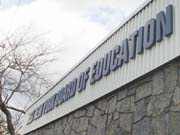The West New York Board of Education announced last week that the school district has received certification from the state of New Jersey. This means that the district passed all 31 indicators set by the state during its evaluation process this year. West New York was the only one of the state’s 30 urban “special needs” school districts to pass this year, officials said.
Certification lasts for a seven-year period, during which the state conducts periodic audits to assure that the district is maintaining the standards of education set forth by the state.
There are eight evaluation standards involved in the certification process. Each standard has a certain number of subdivisions that add up to 31 “indicators.” Schools that do not pass all 31 will face re-evaluations until they pass and can get certified. The eight indicators are: quality assurance, school-level planning, curriculum and instruction, pupil performance, pupil behavior, teaching staff/professional development, school resources, and mandated programs.
“This is a big deal, because classically, Abbott districts do very poorly on all sections of state testing,” said Rosemary Alesandro, director of curriculum for the West New York Board of Education, last week. “We’re really happy about this. It’s a testament to everyone working together.”
There are six elementary schools (K-8) and one high school (Memorial) in the West New York district. According to Alesandro, there are approximately 9,500 students in the district.
State testing is a major component of how Abbott districts are judged. And according to the Board of Education numbers, West New York is way ahead of the pack, score-wise.
Two different tests were given in the last year: The “Elementary School Proficiency Assessment” (ESPA) test, given in May 2002 to fourth-graders, and the “Grade Eight Proficiency Assessment (GEPA) test, given in March 2002 to eighth graders. On the ESPA test, 77.4 percent of West New York students passed both language arts and math sections, while only 42.4 percent of students in the 29 other Abbott districts passed.
Showing an even wider gap was the GEPA test, which is given to eighth-grade general education students and includes a science component. 80.3 percent of West New York’s eighth graders passed that test, while 28.5 percent of students in other Abbott districts passed all three sections.
According to West New York Superintendent of Schools Anthony Yankovich, communication is what makes the district as successful as it is. “Communication is so important. You have to listen to what’s happening in the classrooms and to react to those needs,” he said.
Students at the elementary level that do not meet the minimum state testing criteria are, according to Alesandro, “placed in a ‘basic skills’ program, and for three days a week would receive extra instruction in whatever subject they are deficient in.”
High school students who don’t meet the criteria are placed in after-school programs that the West New York school district calls “Extended Day Programs.”
Yankovich added that there are many key programs in place in West New York that go far in explaining the success it has had. “We test each student before they move on to the next grade,” he said. “This isn’t state mandated, mind you. If they are found to be lacking in a certain area, they will be coached in that area. We have also implemented a reading program, which is so important. You have to build a foundation.”
On the administrative and professional end, the Board of Education has implemented a supervisory program in “content” areas such as math, science and language arts. According to Yankovich, these supervisors, also known as “district supervisors,” go into the schools, visit the classrooms and assist the teachers in their particular area. A “common planning period” is worked into the school schedule, which allows the teacher to sit with the supervisor and go over any questions, concerns or problems they may be having with their given curriculum. Said Yankovich, “The professional development of teachers is so important.”
New school buildings
On the school construction front, work is progressing on the new middle school that is currently under construction on Broadway between 54th and 57th streets. Yankovich said that the school will “most likely” open in September of 2004.
Director of Facilities and Security Richard Loschiavo also indicated that a flurry of “school replacements” will be occurring in the near future.
“Schools One (on Madison Street), Three (on Polk Street), Four (On 66th Street), Five (on Hudson Avenue) and Six (also known as the “Harry L. Bain School” on Broadway) are slated to be replaced,” said Loschiavo. “Schools Three, Four and Six will be getting new buildings in new locations, and schools One and Five will be torn down and rebuilt.” This ambitious project is being paid for, according to Loschiavo, with state funds overseen by the Economic Development Authority.
Students will be shifted among buildings while the replacements are underway.
Loschiavo added that the construction planning for schools Three and Four is currently in the midst of a state feasibility study and the projected opening date is the fall of 2005. School Six is slated to be opened at the same time, but according to Loschiavo, “that’s still a bit up in the air.” Construction on schools One and Five, according to Loschiavo, won’t start until Three, Four and Six are done to make room for the students displaced by the construction of the other three.
